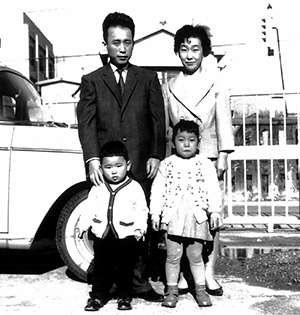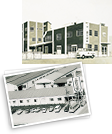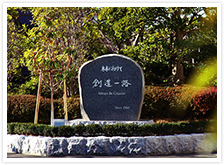
Since the foundation of Fuji Kombu Co., Ltd. in 1960, we have constantly been focusing on providing healthy, tasty, reliable and safe products. Having started from traditional Japanese foods with kombu and beans, we have created new values through our creative minds with our main concept, health, at the center, introducing the world’s food culture.
They are the founder of the company, Hachiro Yamagishi and his family.
He was an entrepreneur and made innovations.
Fujicco’s approach in the past can be found here.
 R&D/MARKETING TOPICS
R&D/MARKETING TOPICS

- Launched first product tororo kombu, Isonoyuki 50g for 30 yen (1960)
- Started TV commercial advertisement (1963)
- Established Fujicco brand (1966)

- Established Product Development Section and Sensory Analysis Section (1968)
- Launched Fujicconi: packed tsukudani (1971)
- Stopped using saccharin for tororo kombu. Used 100% distilled vinegar (1973)

- Started Bell Mark activities (1974)
- Started displaying package date for dry foods such as Juntoro (1975)

- Developed Omamesan with no added chlorine, coloring or artificial preservatives (1976)
- Established Mifuji: brand of gift-use premium tsukudani shops(1977)
- Developed Daizumizuni: soybean boiled in water series for supporting home cooking (1978)
- Started freshness-keeping and deoxidized packaging for Juntoro (1978)
- Stopped artificial preservatives in Fujicconi (1980)
- Stopped artificial preservatives in all products (1982)
- Developed deoxidizes packaging of cup containers for Fujicconi (1986)
- Launched Tsukemono Hyakusen. Popularized by TV commercial (1987)
- Established Daily Prepared Foods Division (1989)
- Developed method to extract kelp minerals (1991)
- Started Fuji Clair wine sales (1992)
- Started in-house production of Nata de coco. Nata de coco became popular in Japan (1993)
- Developed method to extract soy isoflavones. Started isoflavone business (1996)
- Received long seller award for Omamesan (1996)
- Developed isoflavone 12 component test reagent (1996)

- Launched packaged delicatessen Okazubatake (1997)
- Acquired US patent for technique to improve taste of isoflavones (1998)
- Launched Daizugacha: tea of soybean germ with isoflavones (1999)

- Certified Daizugacha as Food for specified health use (2001)
- Started production of bacterial culture of Caspian Sea Yogurt (2002)
- Acquired EU (UK, Germany, France) patent for technique to improve taste of isoflavone (2002)
- Published Beans Life: health information magazine (2003)

- Established Caspia: official brand of yogurt shops in department stores (2004)
- Received Technology Prize from The Brewing Society of Japan for Kiwi Wine Study (2004)
- Developed technique for determining production regions for Tambaguro (2004)
- Launched Caspian Sea Yogurt plain for retail (2005)
- Started holding events such as Yogurt Forum and Omame University (2005)
- Developed and launched Chrono Care polyphenol extracted from black soybean seed coat (2007)
- Certified November 18th as “Caspian Sea Yogurt Day” (2007)
- Announced health benefits of seaweed at International Seaweed Symposium (2007)
- Announced visceral fat suppression effect of Chrono Care (2007)

- Developed and launched Soft Deli: care food for the elderly (2008)
- Confirmed immunostimulating effect of exopolysarride (EPS) produced by Caspian Sea Yogurt culture (2008)
- Opened Dietary Education Museum at headquarters (2009)
- Established Donan Makombu Mahoya: brand of premium tsukudani shops (2009)
- Confirmed blood sugar suppression effect of Caspian Sea Yogurt (2009)
- Confirmed blood sugar suppression effect and active ingredient Procyanidin of black soybeans (2009)
- Received food industry technology distinguished service award for Caspian Sea Yogurt Promotion Activities (2010)
- Promoted Dietary educational activities such as harvesting and cooking (2010)
- Confirmed biological antioxidant effect of Chrono Care (2010)
- Confirmed benefit of Caspian Sea Yogurt on influenza infection (2010)
- Developed soybeans with high levels of isoflavones and applied variety registrations (2010)
- Launched Okazubatake Boiled fish and Okazubatake Blister series (2011)

- Launched Asanotaberu soup: packaged soup for breakfast (2011)
- Launched Bästa Deli: packaged and convenient delicatessen (2013)
- Confirmed benefit of Caspian Sea Yogurt on atopic dermatitis (2014)
- Announced swelling improvement of black soybeans polyphenol (2015)
- Received Minister of Agriculture, Forestry and Fisheries award for Soft Deli Beans and Vegetables in Care Food Competition (2015)
- Distribution of bacterial culture of Caspian Sea Yogurt reached 5 million people (2015)
- Steamed soybeans were certified as Food with Function Claims first among soybeans processed foods (2015)
- Announced vascular endothelial function improvement of black soybeans polyphenol (2017)
- Launched Yogurt made from soybeans (2020 )
 MANAGEMENT TOPICS
MANAGEMENT TOPICS
- Established Fujikombu Co., Ltd. in Kobe city. Capital: 1 million yen. First period sales: 30 million yen (1960)

- Established company policy (1962)
- Established headquarters and factory in Nishinomiya city. Established Tokyo branch office (1963)
- Established Fujikon Syokuhin Co., Ltd. (1968)
- Sales reached 1 billion yen. Capital: 60 million yen (1969)
- Established Wadayama Factory (1972)
- Inspected Paris International Trade Fair / Zenoa Food Exhibition (1974)

- Sales reached 5 billion yen. Capital: 140 million yen (1975)
- Established Kanto Factory (1976)
- Sales reached 10 billion yen. Capital: 235 million yen (1980)
- Established company motto "Always Be Creative" (1980)
- Established Naruo Factory (1980)
- Sales reached 20 billion yen. Capital: 461 million yen (1984)
- Received Food and Marketing Bureau chief award from the Ministry of Agriculture, Forestry and Fisheries of Japan for establishing additive-free techniques and new product development efforts (1984)

- Changed company name from Fujikombu Co., Ltd. to FUJICCO CO., LTD. (1985)
- 25th Anniversary. Started pine tree contribution activities throughout Japan (1985)
- Merged FUJICCO CO., LTD. and Fujicco Syokuhin Co., Ltd. Capital: 1,275 million yen (1988)
- Established Tokyo Factory (1988)
- Changed fiscal year end from August to March. Capital: 2,175 million yen (1989)
- Established Mifuji Co., Ltd as gift-use premium product sales department (1989)
- Started joint research with universities and research institutes (1989)
- 30th Anniversary. Listed on the 2nd section of the Osaka Securities Exchanges. Capital: 5,851 million yen (1990)
- Established Fujicco Winery (1990)
- Established FF Center (headquarters building) in Kobe city (1991)
- Established Tsingtao FUJICCO CO., LTD. (1995)
- [Isoflavone Bioactive Research] Dispatched to the WHO (World Health Organization) cardiac study, epidemiological study (1995)
- Listed on the 2nd section of the Tokyo Stock Exchanges. Capital: 6,566 million yen (1996)
- Listed on the 1st section of the Tokyo Stock Exchange and Osaka Securities Exchange (1997)
- Sales reached 40 billion yen (1999)
- Started in-house detection system for genetic modification (PCR). Enhanced display of product origin (1999)
- President Hachiro Yamagishi received Food Industry Distinguished Service Award (1999)
- President Hachiro Yamagishi received 5th Class Orders of Sacred Treasure (2000)
- Established Food Safety Inspection Section (2002)
- [Local support] Started free seaweed mineral capsules distribution through the society for Eliminating Nepalese Iodine Deficiency NPO (2002)
- Established new factory for Fujicco Food (2002)
- Masakazu Fukui as appointed President, and Hachiro Yamagishi as Chairman (2004)
- Established Kakogawa branch factory (2004)
- Acquired HACCEP certification for Tsingtao FUJICCO CO., LTD. (2006)
- Established Kansai Distribution Center (2006)
- 11 workplaces integrated certification of ISO9001 (2006)
- Received food industry technology distinguished service award: Most Comprehensive Development of Kelp (2007)
- Started Yamagishi Hachiro Scholarship Fund at Kobe University (2008)
- Expanded headquarters (2009)
- Started proposal of ”Neo Japanese Style Diet” (2010)
- Sales reached 50 billion yen (2010)
- 50th Anniversary. Established monument with the company motto, "Always Be Creative" (2010)
- Closed Nishinomiya Factory, and integrated with Naruo Factory (2011)
- Food Safety Inspection Section started testing radioactive material (2011)
- Started solar power generation (2013)

In 2010, we build this monument at the entrance of our headquarters with our company motto, “Always Be Creative”to commemorate our 50th Anniversary. It is a testament to the commitment of each Fujicco employee to remember this motto and our policy to always challenge. - Founder Mr. Hachiro Yamagishi passed away (2014)
- Merged Fujicon Food Co., Ltd. and Fujicco Foods Co., Ltd. (2016)
- Established Audit and Supervisory Committee (2016)
- Sales reached 60 billion yen (2017)
- Acquired Foods Palette Co., Ltd. (2019)
- Dissolution of Mifuji Co., Ltd. (2020)
- Kanto factory new factory building completed (2021)
- Invested in PT. FUJICCO FOODS INDONESIA and started joint venture (2021)
- Newly built "Tokyo FF center" in Bunkyo-ku, Tokyo (2021)
